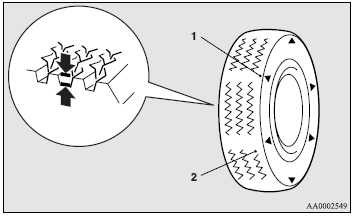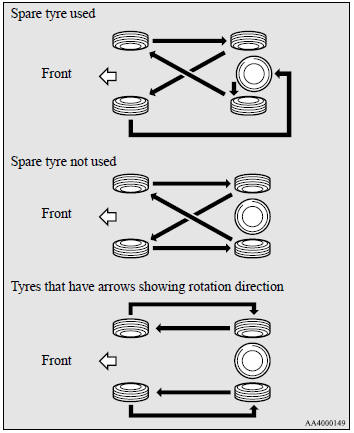 Mitsubishi Outlander: Tyres
Mitsubishi Outlander: Tyres
WARNING:
● Driving with tyres that are worn or improperly inflated can result in a collision
and serious or fatal injury.
Tyre inflation pressures

*: Above 160 km/h (100 mph).
Check the tyre inflation pressure of all the tyres while they are cold; if insufficient or excessive, adjust to the specified value. After the tyre inflation pressure has been adjusted, check the tyres for damage and air leaks. Be sure to put rubber caps on the valves.
Wheel condition

1- Location of the tread wear indicator. 2- Tread wear indicator.
Check the tyres for cuts, cracks and other damage. Replace the tyres if there are deep cuts or cracks. Also check each tyre for pieces of metal or pebbles. The use of worn tyres can be very dangerous because of the greater chance of skidding or hydroplaning. The tread depth of the tyres must exceed 1.6 mm in order for the tyres to meet the minimum requirement for use. Tread wear indicators will appear on the surface of the tyre as the tyre wears, thereby indicating that the tyre no longer meets the minimum requirement for use. When these wear indicators appear, the tyres must be replaced with new ones. When replacement of any of the tyres is necessary, replace all of them.
CAUTION:
● Always use tyres of the same size, same type, and same brand, and which have no
wear differences. Using tyres of defferent size, type, brands or degree of wear,
will increase the differential oil temperature, resulting in possible damage to
the driving system. Further, the drive train will be subjected to excessive loading,
possibly leading to oil leakage, component seizure, or other serious faults.
Replacing tyres and wheels
CAUTION:
● Avoid using different size tyres from the one listed and the combined use of different
types of tyres, as this can affect driving safety. Refer to “Tyres and wheels” on
page 9-9.
● Even if a wheel has the same rim size and offset as the specified type of wheel,
its shape may prevent it from being fitted correctly. We recommend you to consult
a specialist before using wheels that you have.
Tyre rotation

Tyre wear varies with vehicle conditions, road surface conditions and individual driver’s driving habits. To equalise the wear and help extend tyre life, it is recommended to rotate the tyres immediately after discovery of abnormal wear, or whenever the wear difference between the front and rear tyres is recognisable. When rotating tyres, check for uneven wear and damage. Abnormal wear is usually caused by incorrect tyre pressure, improper wheel alignment, out of balance wheel, or severe braking. We recommend you to have it checked to determine the cause of irregular tread wear.
CAUTION:
● A compact spare tyre can be fitted temporarily in place of a tyre that has been
removed during the tyre rotation. However, it must not be included in the regular
tyre rotation sequence.
● If the tyres have arrows (A) indicating the correct direction of rotation, swap
the front and rear tyres on the left-hand side of the vehicle and the front and
rear tyres on the right-hand side of the vehicle separately. Keep each tyre on its
original side of the vehicle. When fitting the tyres, make sure the arrows point
in the direction in which the wheels will turn when the vehicle moves forward. Any
tyre whose arrow points in the wrong direction will not perform to its full potential.

CAUTION:
● Avoid the combined use of different types of tyres. This can affect driving safety.
Snow tyres
The use of snow tyres is recommended for driving on snow and ice. To preserve driving stability, mount snow tyres of the same size and tread pattern on all four wheels. A snow tyre that is worn down more than 50% is no longer appropriate to use. Snow tyres which do not meet specifications must not be used.
CAUTION:
● Observe permissible maximum speed for your snow tyres and the legal speed limit.
NOTE:
● The laws and regulations concerning snow tyres (driving speed, required use, type,
etc.) vary. Find out and follow the laws and regulations in driving area.
● If flange nuts are used on your vehicle, change to tapered nuts when steel wheels
are used.
Tyre chains
If tyre chains have to be used, ensure that they are fitted only on the drive wheels (front) in accordance with the manufacturer’s instructions. Use only tyre chains which are designed for use with the tyres mounted on the vehicle: use of the incorrect size or type of chain could result in damage to the vehicle body. Contact a MITSUBISHI MOTORS Authorised Service Point before putting on tyre chains. The max chain height is as follows.

When driving with tyre chains on the tyres, do not drive faster than 50 km/h (31 mph). When you reach roads that are not covered in snow, immediately remove the tyre chains.
CAUTION:
● Practice fitting the chains before you need them. Don’t expect help from other
people in the cold.
● Choose a clear straight stretch of road where you can pull off and still be seen
while you are fitting the chains.
● Do not fit chains before you need them. This will wear out your tyres and the
road surface.
● After driving around 100-300 meters (109-328 yard), stop and retighten the chains.
● Drive cautiously and do not exceed 50 km/h (31 mph). Remember that preventing
accidents is not the purpose of tyre chains.
● When tyre chains are installed, take care that they do not damage the disc wheel
or body.
● Do not install a tyre chain on an emergency wheel which is compact in size. If
one of the front wheels has punctured, replace it with one of the rear wheels and
install the compact spare wheel in that place before fitting a tyre chain.
● An aluminium wheel can be damaged by a tyre chain while driving. When fitting
a tyre chain on an aluminium wheel, take care that any part of the chain and fitting
cannot be brought into contact with the wheel.
● Remove the wheel covers before installing a tyre chain, otherwise they may be
damaged by the tyre chain (see page 6-12).
● When installing or removing a tyre chain, take care that hands and other parts
of your body and not injured by the sharp edges of the vehicle body.
NOTE:
● The laws and regulations concerning the use of tyre chains vary. Always follow
local laws and regulations. In most countries, it is prohibited by the law to use
of tyre chains on roads without snow.
 Battery
Battery
The condition of the battery is very important for quick starting and to keep
the vehicle’s electrical system working properly. Regular inspection and care are
especially important in cold weath ...
 Parking brake break-in
Parking brake break-in
Break-in the parking brake linings whenever the brake performance of the parking
brake is insufficient or whenever the parking brake linings and/or discs are replaced,
in order to assure the best ...
See also:
Fast-forwarding and reversing songs
To fast-forward or reverse, press ...
Driving in foreign countries
When planning to use your vehicle in
another country:
- Confirm the availability of the correct
fuel. Refer to “Fuel requirements”.
- Comply with all regulations and requirements
of each ...
